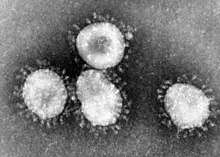Avian coronavirus
Avian coronavirus (IBV) is a coronavirus that infects birds, causing the associated disease avian infectious bronchitis (IB). It is a highly infectious avian pathogen that affects the respiratory tract, gut, kidney and reproductive systems of chickens.[3][4]
| Avian coronavirus | |
|---|---|
 | |
| Avian coronavirus virions viewed under an electron microscope | |
| Virus classification | |
| (unranked): | Virus |
| Realm: | Riboviria |
| Kingdom: | Orthornavirae |
| Phylum: | Pisuviricota |
| Class: | Pisoniviricetes |
| Order: | Nidovirales |
| Family: | Coronaviridae |
| Genus: | Gammacoronavirus |
| Subgenus: | Igacovirus |
| Species: | Avian coronavirus |
| Synonyms | |
IBV affects the performance of both meat-producing and egg-producing chickens and is responsible for substantial economic loss within the poultry industry.[5]
Classification
IBV is in the genus Gammacoronavirus,[6] or group 3,[5] with a non-segmented, positive-sense single-stranded RNA genome.[7]
It is the type species of its Genus Igacovirus, today. And, when there was only one genus in the Coronaviruses, the genus Coronavirus, it was the type species of the group of all known coronaviruses.[8]
Pathology
Respiratory system
When inhaled, virus will attach to glycoprotein receptors containing sialic acid on ciliated epithelial cells of the respiratory epithelium. The respiratory replication will result in loss of ciliary activity,[9] mucus accumulation, necrosis and desquamation, causing respiratory distress, râles and asphyxia. Local virus replication will result in viremia, spreading the infection into other tissues and organs. Other respiratory diseases of chickens (Mycoplasma gallisepticum, avian infectious laryngotracheitis (Gallid alphaherpesvirus 1), Newcastle disease (avian paramyxovirus 1), Avian metapneumovirus infection may be confused clinically to infectious bronchitis.
Kidney
Through viremia, some nephrotropic strains (most of high virulence) could infect the kidney epithelium in tubules and nephron, causing kidney failure. At gross examination, kidneys may appear swollen and pale in color and with urates in ureters
Reproductive system
In hens, the viremic IBV will also reach the oviduct, causing lesions in the magnum (the egg-white gland) and in the uterus (the egg-shell gland), leading to a sharp decline of egg production, shell-less, fragile or roughened shells eggs (uterus lesion) with watery whites (magnum lesion). Infection of chickens at puberty, during the oviduct development, will impede oviduct formation and destroy future laying capacity, resulting in "false layers". However, other diseases affecting layer chickens could lead to that condition.[10]
Vaccines
There are both attenuated vaccines and inactivated vaccines available. Their effectiveness is diminished by poor cross-protection. The nature of the protective immune response to IBV is poorly understood, but the surface spike protein, the amino-terminal S1 half, is sufficient to induce good protective immunity. Experimental vector IB vaccines and genetically manipulated IBVs—with heterologous spike protein genes—have produced promising results, including in the context of in ovo vaccination.[5]
References
- ICTV 7th Report van Regenmortel, M.H.V., Fauquet, C.M., Bishop, D.H.L., Carstens, E.B., Estes, M.K., Lemon, S.M., Maniloff, J., Mayo, M.A., McGeoch, D.J., Pringle, C.R. and Wickner, R.B. (2000). Virus taxonomy. Seventh report of the International Committee on Taxonomy of Viruses. Academic Press, San Diego.1162 pp. https://talk.ictvonline.org/ictv/proposals/ICTV%207th%20Report.pdf
- de Groot, Raoul J.; et al. (2008). "Revision of the family Coronaviridae" (PDF). p. 24. Retrieved 9 March 2020.
Avian coronavirus (new) (comprised of existing species infectious bronchitis virus, turkey coronavirus, pheasant coronavirus, duck coronavirus, goose coronavirus, pigeon coronavirus)
- Casais, R.; Thiel, V.; Siddell, S.G.; Cavanagh, D.; Britton, P. (2001). "Reverse genetics system for the avian coronavirus infectious bronchitis virus". Journal of Virology. 75 (24): 12359–12369. doi:10.1128/JVI.75.24.12359-12369.2001. PMC 116132. PMID 11711626.
- Cavanagh, D. (2001). "A nomenclature for avian coronavirus isolates and the question of species status". Avian Pathology. 30 (2): 109–115. doi:10.1080/03079450120044506. PMID 19184884.
- Cavanagh, D (2007). "Coronavirus avian infectious bronchitis virus". Veterinary Research. 38 (2): 281–97. doi:10.1051/vetres:2006055. PMID 17296157.

- Bande, F; Arshad, SS; Omar, AR; Bejo, MH; Abubakar, MS; Abba, Y (2016). "Pathogenesis and diagnostic approaches of Avian Infectious Bronchitis". Advances in Virology. 2016: 4621659. doi:10.1155/2016/4621659. PMC 4756178. PMID 26955391.
- de Vries, A.A.F.; Horzinek, M.C.; Rottier, P.J.M.; de Groot., R.J. (1997). "The genome organisation of the Nidovirales: similarities and differences between arteri-, toro-, and coronaviruses". Seminars in Virology. 8: 33–547. CiteSeerX 10.1.1.462.1825. doi:10.1006/smvy.1997.0104.
- Cann, Alan, ed. (2006). "Coronaviruses". Microbiology @ Leicester. University of Leicester, School of Biological Sciences. Archived from the original on 9 March 2007. Retrieved 15 June 2020.
Family: Coronaviridae; (Subfamily): ; Genus: Coronavirus; Type Species: Infectious bronchits virus
- "Ciliary activity of chicken tracheal epithelial cells". YouTube. 15 November 2010. Retrieved 23 September 2013.
- "Infectious Bronchitis: Introduction". The Merck Veterinary Manual. 2006. Archived from the original on 22 June 2007. Retrieved 17 June 2007.
Further reading
- Gomaa, M.H.; Barta, J.R.; Ojkic, D.; Yoo, D. (2008). "Complete genomic sequence of turkey coronavirus". Virus Research. 135 (2): 237–246. doi:10.1016/j.virusres.2008.03.020. PMID 18468711.